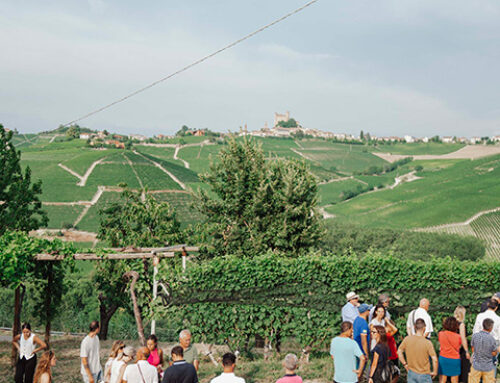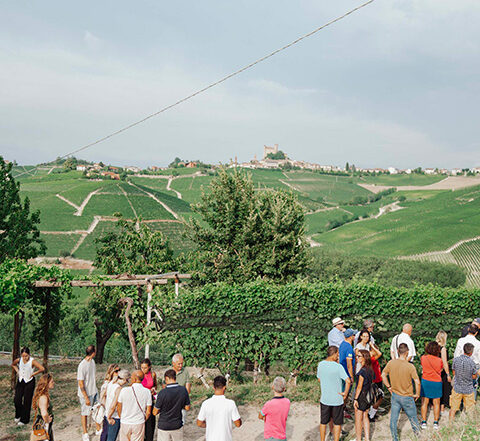Growing up among these hills, I’ve learned to understand and respect the value of terroir: that subtle alchemy of soil and climate, enriched by human endeavor, that gives the wines of Langhe a unique character. Here, each vineyard tells a story, an unbreakable bond between land, tradition, and innovation. Today, I’d like to guide you through the peculiarities of our four geographical indications, each a testament to the diversity that defines our land.
What Does Terroir Mean?
When I think about the terroir of our lands, I see much more than the soil beneath my feet or the climate that caresses our vines. The terroir is the soul of every bottle, a perfect synthesis between nature, our dedication, and the traditions that have nourished these hills for generations. It’s a very complex concept and hard to translate: it involves the combination of soil, altitude, exposure, and microclimate, making each vineyard irreplaceable and distinct.
It’s what makes each of our harvests an act of faith towards the land we love.
We are in the land of Langa, where steep slopes and vines seem to dance to the rhythm of the seasons. Here, Nebbiolo, Barbera, Dolcetto, and Arneis are not just grapes: they are living expressions of a territory that speaks through them. Every sip is a dialogue with the land, a story of passion and patience, challenges, and triumphs.
That’s why terroir is not just a place, but an unbreakable bond that connects the land to those who cultivate it with love and respect. In Langhe, this bond translates into wines that are true masterpieces, recognized and celebrated all over the world.
Ecco perché il terroir non è solo un luogo, ma un legame indissolubile che unisce la terra a chi, con amore e rispetto, la coltiva. Nelle Langhe, questo legame si traduce in vini che sono veri e propri capolavori, riconosciuti e celebrati in tutto il mondo.

Geology and Terroir: The Secret of Langhe’s Soils and the Uniqueness of Our Geographical Indications
Scholars call it geology.
I prefer “millennium-old secrets guarded by the soils.”
This story begins millions of years ago, in the Ligurian-Piedmont Tertiary Basin, a vast expanse of water that, upon receding, left behind a geological treasure destined to shape the fate of these hills. Here, where lush vine rows stand today, the marine past infused the soil with marls and sandstones, creating a unique stage for the birth of wines with an unmistakable character.
The Wines of Langhe Are Born from a Dialogue with the Land
But the magic of the Langhe’s terroir does not reside only in its geological origin. The land here speaks through the altitudinal variation and the division into three distinct sectors, different scenarios that together compose a mosaic of microclimates and soils. This diversity is the cradle of our geographical indications, each with its own story, a tale of soil, climate, and human hand intertwined to give life to wines with distinctive organoleptic profiles.
Imagine the hands of a vintner, carefully selecting each cluster as if it contained the essence of a piece of terrestrial history. Winemaking and agronomic decisions are never left to chance but are inspired by the desire to respect and enhance the uniqueness of each geographical indication. Thus, the work in the vineyard and cellar becomes a continuous dialogue with the land, a commitment to bring to the glass not just a wine, but the living narrative of its terroir of origin.
The Four Geographical Indications
Each geographical indication reflects a unique dialogue between nature and culture. A different story, expression of the varied characteristics of soil, climate, and altitude.
- MGA Castelletto: This indication speaks of elegance and freshness, influenced by soils from the Formation of Lequio and Arenarie di Diano that give the wines good structure, with a generally late harvest that emphasizes salinity and aromatic complexity.

- MGA Perno: Located to the southeast, the vineyard of Perno benefits from a climate that delays grape maturation, giving Barolo Perno a solid character and an organoleptic profile that ranges from earthy to fruity, with a firm structure.

- MGA Bussia: One of the most extensive and historic, where the Sandy Marls of Sant’Agata Fossili predominate, contributes to a Barolo with solid structure and austere character, with a bouquet in which earthy notes emerge.

- MGA Ravera: Characterized by Laminated Marls of Sant’Agata Fossili, this indication gives wines with ripe and generous fruit, a good structure, and smoothed tannins, the result of fertile soil and a good water capacity.

The Wines of Langhe Respect the Terroir
As you now well know, at the heart of our winemaking is a deep respect for the terroir that surrounds us. This commitment translates into oenological practices that not only preserve but enhance the essence of each specific area of the Langhe. We use gentle and non-invasive methods to ensure that every drop of wine reflects the land from which it comes, paying particular attention to the timing of harvest, the selection of grapes, fermentation, and aging.
Ours is a choice of balance, where human intervention aspires to be a means through which the terroir can fully express itself, ensuring that the peculiarities of each geographical indication are celebrated in the glass.
Wines of Langhe: Taste the Four Geographical Indications
I invite you to taste the wines produced from our four geographical indications, to appreciate their differences and discover the unique organoleptic nuances. Through these wines, I share not only a piece of our heritage but also a fragment of my life, woven together with the millennia-old hills of the Langhe.
Bibliography:
Share on your favorite platform:
Related articles












